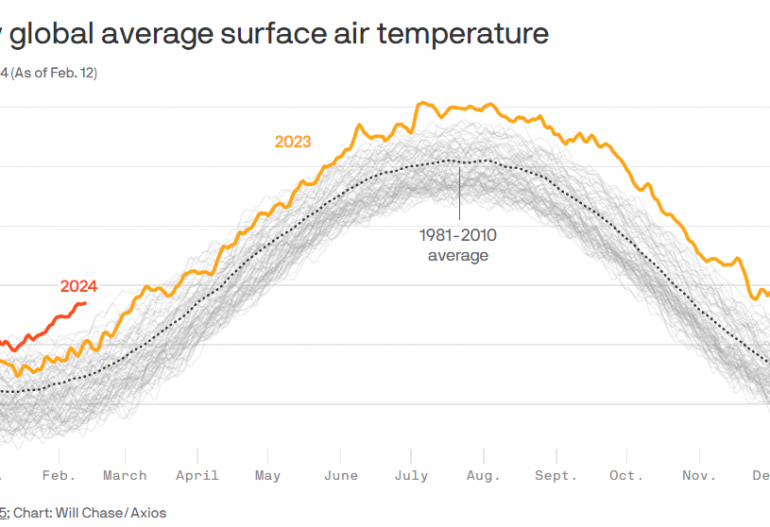2023 was another year of record warmth and costly climate-related disasters, including right here in New England. Here’s our latest annual on the globe’s health, as expressed in six charts. As the black line in the first chart shows, 2023 was a year when global warming went “off the charts!”

2023 stands out as the warmest year on record (dating back to 1850.) It was also the first year to exceed 1.5 °C (2.7 °F) of warming since the start of the Industrial Revolution. (More on that later.) The prior temperature record set in 2016 was shattered by a wide margin. As El Niño conditions set up in the Pacific Ocean early last year, the last seven months of 2023 each reached new monthly temperature records. July was the hottest month ever recorded, and September posted the biggest gain in average monthly temperature. Altogether, 2023 was about 1.54 °C (2.77 °F) warmer than the average for the period 1850 to 1900.
Warming Relative to 20th Century Averages
About one-sixth of the Earth’s surface set annual temperature records in 2023. The map above shows how local temperatures have increased relative to the average temperature in 1951-1980. In 2023, extreme warming took place in the North Atlantic basin and in the eastern Pacific basin, largely influenced by El Niño conditions and other naturally occurring factors. However, both land and sea surface temperatures set new observational records in 2023, with faster warming occurring over land masses. The rate of warming in the Arctic region is now about four times faster than the global average, due mainly to shrinking sea ice and snow cover over the last 40 years.
The U.S. experienced a record number of billion-dollar weather disasters in 2023, totaling $92.9 billion in damages over 28 events. The costliest disasters were the summer-long heat wave and drought that struck the South and Midwest ($14.5 billion) and tornado outbreaks over the South and East in early March ($6.0 billion). Severe July storms brought flooding and devastation to many Vermont communities and other portions of New England ($2.2 billion). Canada’s wildfires in June also resulted in unprecedented air-quality alerts in the Northeast and Midwest, with New York suffering the worst air quality of any city in the world for a brief time. Wildfires also devastated Maui ($5.6 billion). Such costly weather disasters (adjusted for inflation) are also happening more often. In the U.S., billion-dollar weather disasters have increased from a rate of about one every six weeks over the last 40 years to one every 18 days (on average) over the last five years.
The long-term warming trend is approaching 1.5° C (2.7 °F) worldwide, a threshold that scientists warn could mark a tipping point for even more costly health and property damage. Each of the last nine years (2015-2023) now ranks among the top 10 warmest years on record – and 2024 could make it 10 for 10. Even though the current El Niño is forecast to dissipate by the middle of the year, its legacy is likely to sustain much higher global average temperatures throughout the year. As one early warning sign, Atlantic Ocean temperatures as of mid-February already reached levels not normally seen until mid-July, setting the stage for a possibly very active 2024 hurricane season. Based on historical variability and current warming trends, 2024 is expected to rival 2023 as either the warmest or second-warmest year on record.
Warming Projected through 2050
Temperatures are rising mainly in response to continued growth in carbon dioxide emissions from human activities. U.S. carbon emissions were down 3 percent in 2023, due mainly to an ongoing switch from burning coal to natural gas and renewables for power generation. Globally, however, the amount of carbon dioxide emitted in 2023 rose by 1.1% to set a new all-time high. The carbon dioxide level in Earth’s atmosphere eclipsed 420 parts per million, up from 315 ppm in 1958 when the first direct measurements took place. In 2015, many countries participating in the Paris Agreement set an aspirational goal to limit long-term global warming to no more than 1.5 °C (2.7 °F). After breaching this limit for the first time in 2023, the Earth’s climate now is expected to regularly exceed 1.5 °C of warming over the next decade and may reach 2.0 °C of warming by shortly after 2050.
Global CO₂ emissions from fossil fuels hit a record high in 2023; that’s about twice the amount of 40 years ago. At the same time, annual global CO₂ atmospheric concentrations climbed to more than 50% above pre-industrial levels. To stay on track with long-term climate stabilization goals, international negotiators are trying to achieve a 43% cut in worldwide CO2 emissions by 2030 and 100% renewable energy production by 2050. In 2023, global renewable electricity production increased by a record 440 gigawatts, putting total renewable electricity generating capacity (including hydropower) at about 4,500 GW. Achieving a net zero emissions target by 2050 would require a nearly ten-fold increase in renewable energy production relative to today’s level, even with zero growth in overall global energy demand.
Are you ready to step into the future in ways that will lower your carbon footprint, save money, and tackle climate change? Solaflect Energy is your home energy management partner. We help you install clean and affordable solar electricity and solar-powered workplace EV charging systems for a more resilient and climate-friendly future. For more information email us, or call (802) 649-3700.




